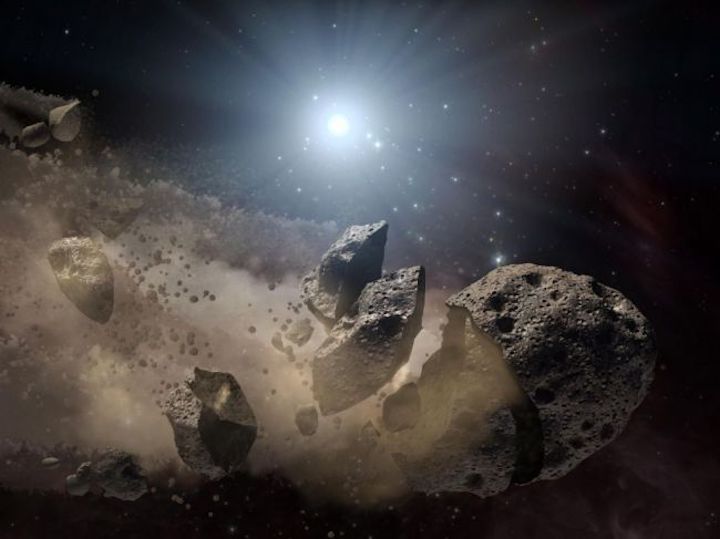19.10.2019
It was a crunch visible light-years away.

Somewhere in the galaxy, a white dwarf star suddenly started shining brightly. And now we understand the violent cataclysm that caused it: the star's gravitational field tore the asteroid to bits, scattering its metallic bits in a shiny halo around the star.
There's no telescope video of an asteroid shattering across space. But here's what we do know: There's a white dwarf star in our galaxy that, for years, emitted a consistent amount of mid-infrared (MIR) light. Then, in 2018, these emissions changed. Over the course of six months, the starlight from that point in space got about 10% more intense in the MIR spectrum — and that point is still getting brighter. The researchers think that's because of a newly formed cloud of metallic dust between Earth and the star, likely due to the recent breakup of the asteroid.
To an outsider, it may sound counterintuitive that a cloud of dust would make a star look brighter. But Tinggui Wang, an astronomer at the University of Science and Technology of China and lead author of a paper describing the event, said the brightening makes sense if you think about how the star and the cloud interact.
"When the debris are on our line of sight to the star, it would make the star dim," he told Live Science. "However, the [individual pieces of] debris cover only a small fraction of the sky, so the chance of being on the line of sight is small."
However, although individual pieces of debris are small and each cover only a tiny patch of sky, the whole cloud is large — much larger than the star. Under normal conditions, only photons that fly out of the star directly at Earth reach human telescopes. But the cloud changes that. Beams of light aimed in all sorts of directions strike the cloud of the debris, heating it up and causing the bits of asteroid to emit MIR light. That light reaches Earth too, even though the beams of light that caused it normally wouldn't have. The result is a bigger glowing region of the sky that our telescopes register as a spike in light, Wang said.
Imagine a faint flashlight in the distance on a clear night. If it's pointed right at you, you might notice it as a thin dot of light. But if you shine the flashlight through the billowing steam of a fog machine, there's a much bigger, bright object to catch your eye — even if the power of the light source stays the same.
Astronomers have seen clouds of debris like this before in space, said Malena Rice, an expert in the astronomy of debris disks around distant stars and doctoral student in the Yale University Department of Astronomy. And they've seen evidence of nonspherical objects, likely asteroids orbiting objects outside our solar system — possibly another white dwarf. But this may be the first time astronomers have spotted an asteroid disintegrating into a debris cloud around a star.
"This process has been theorized for over a decade," Rice, who wasn't involved in the research, told Live Science. "But we've never had a chance to study the full disruption process in action until now."
So, what could have ripped the asteroid to bits? Wang and his colleagues concluded that it was likely a gravitational effect called tidal disruption.
"A white dwarf is a very compact star," Wang said. "As such, close to the star, the gradient of the gravitational field can be very large," meaning gravity can change sharply over a short space.
Imagine you were floating in space, orbiting a star with your feet pointed toward it. The gravity on your feet would be greater than the gravity on your shoulders. If you're standing on Earth right now, you're experiencing the same effect, though the difference — the gradient — is so minimal that you don't notice it.
In the steep gravitational fields close to white dwarfs, Wang said, gradients can become so intense that they overwhelm forces holding an object together. Large asteroids are glued together with their own gravity, but that gravity isn't as strong as the gradients close to white dwarfs. When asteroids pass through those tidal regions, astronomers believe, they shatter, smearing across space as a cloud.
This is related to the reason some planets are surrounded by rings of dust, and not just moons, Rice said. The weaker tidal forces of large planets can keep the matter in their rings from clumping together into balls.
The astronomers are certain the debris wasn't from a comet in this case, Wang said, because comets move so fast that the debris would quickly leave the immediate warm neighborhood around the star and cool down. It's possible that a rocky planet blew up, he said, but the researchers believe a smaller, asteroid-sized object is more likely. (The precise distinction between a large asteroid and a small planet can be a bit vague. But when it comes to other star systems astronomers usually use "exoasteroid" to refer to smaller, jagged metal and rock objects and "exoplanet" to refer to objects large enough that their gravity has formed them into spheres.
Right now, the debris cloud is still circling the star, which goes by the name WD 0145+234. Over time, though, that cloud is likely to fall onto the stellar surface, Wang said. That infalling debris, made of metal and perhaps some warm gas, could explain how many white dwarfs end up with evidence of significant metal pollution in their starlight.
The research has not yet been peer reviewed and was published online Oct. 10 in the preprint journal arXiv.
Quelle: SC
